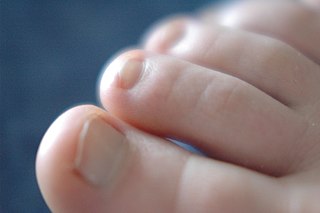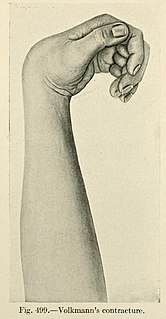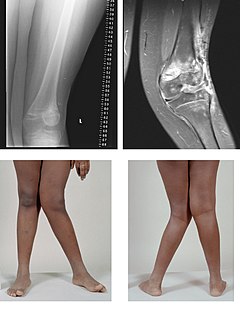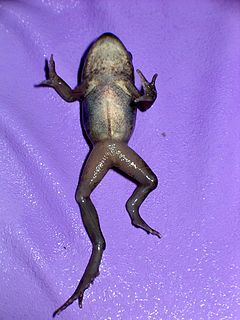
Toes are the digits (fingers) of the foot of a tetrapod. Animal species such as cats that walk on their toes are described as being digitigrade. Humans, and other animals that walk on the soles of their feet, are described as being plantigrade; unguligrade animals are those that walk on hooves at the tips of their toes.

Orthopedic surgery or orthopedics, also spelled orthopaedics, is the branch of surgery concerned with conditions involving the musculoskeletal system. Orthopedic surgeons use both surgical and nonsurgical means to treat musculoskeletal trauma, spine diseases, sports injuries, degenerative diseases, infections, tumors, and congenital disorders.

Clubfoot is a birth defect where one or both feet are rotated inward and downward. The affected foot and leg may be smaller than the other. In about half of those affected, both feet are involved. Most cases are not associated with other problems. Without treatment, people walk on the sides of their feet, which causes problems with walking.

Volkmann's contracture is a permanent flexion contracture of the hand at the wrist, resulting in a claw-like deformity of the hand and fingers. Passive extension of fingers is restricted and painful.

Pes cavus, also known as high arch, is a human foot type in which the sole of the foot is distinctly hollow when bearing weight. That is, there is a fixed plantar flexion of the foot. A high arch is the opposite of a flat foot and is somewhat less common.

A hammer toe or contracted toe is a deformity of the muscles and ligaments of the proximal interphalangeal joint of the second, third, or fourth toe causing it to be permanently bent, resembling a hammer.

A varus deformity is an excessive inward angulation of the distal segment of a bone or joint. The opposite of varus is called valgus. EX: Varus deformity results in a decreased Q angle of the knee joint.

A valgus deformity is a condition in which the bone segment distal to a joint is angled outward, that is, angled laterally, away from the body's midline. The opposite deformation, where the twist or angulation is directed medially, toward the center of the body, is called varus. Common causes of valgus knee in adults include arthritis of the knee and traumatic injuries.

Flat feet is a postural deformity in which the arches of the foot collapse, with the entire sole of the foot coming into complete or near-complete contact with the ground. An estimated 20–30% of the general population have an arch that simply never develops in one or both feet.

The tibialis posterior is the most central of all the leg muscles, and is located in the deep posterior compartment of the leg.
ICD-10 is an international statistical classification used in health care and related industries.
Foot and ankle surgery is a sub-specialty of orthopedics and podiatry that deals with the treatment, diagnosis and prevention of disorders of the foot and ankle. Orthopaedic surgeons are medically qualified, having been through four years of college, followed by 4 years of medical school to obtain an M.D. or D.O. followed by specialist training as a resident in orthopaedics, and only then do they sub-specialise in foot and ankle surgery. Training for a podiatric foot and ankle surgeon consists of four years of college, four years of podiatric medical school (D.P.M.), 3–4 years of a surgical residency and an optional 1 year fellowship.

Hereditary motor and sensory neuropathies (HMSN) is a name sometimes given to a group of different neuropathies which are all characterized by their impact upon both afferent and efferent neural communication. HMSN are characterised by atypical neural development and degradation of neural tissue. The two common forms of HMSN are either hypertrophic demyelinated nerves or complete atrophy of neural tissue. Hypertrophic condition causes neural stiffness and a demyelination of nerves in the peripheral nervous system, and atrophy causes the breakdown of axons and neural cell bodies. In these disorders, a patient experiences progressive muscle atrophy and sensory neuropathy of the extremities.

Fibular hemimelia or longitudinal fibular deficiency is "the congenital absence of the fibula and it is the most common congenital absence of long bone of the extremities." It is the shortening of the fibula at birth, or the complete lack thereof. In humans, the disorder can be noted by ultrasound in utero to prepare for amputation after birth or complex bone lengthening surgery. The amputation usually takes place at six months with removal of portions of the legs to prepare them for prosthetic use. The other treatments which include repeated corrective osteotomies and leg-lengthening surgery are costly and associated with residual deformity.
A foot deformity is a disorder of the foot that can be congenital or acquired.

Ape hand deformity, also known as simian hand, is a deformity in humans who cannot move the thumb away from the rest of the hand. It is an inability to abduct the thumb. Abduction of the thumb refers to the specific capacity to orient the thumb perpendicularly to the ventral (palmar) surface of the hand. Opposition refers specifically the ability to "swing" the first metacarpal such that the tip of the thumb may touch the distal end of the 5th phalanx and if we put the hand on the table as the palm upward the thumb can not point to the sky. The Ape Hand Deformity is caused by damage to the distal median nerve, and subsequent loss of opponens pollicis muscle function. The name "ape hand deformity" is misleading, as apes have opposable thumbs.

Genu recurvatum is a deformity in the knee joint, so that the knee bends backwards. In this deformity, excessive extension occurs in the tibiofemoral joint. Genu recurvatum is also called knee hyperextension and back knee. This deformity is more common in women and people with familial ligamentous laxity. Hyperextension of the knee may be mild, moderate or severe.

Spastic cerebral palsy is the type of cerebral palsy wherein spasticity is the exclusive impairment present. Itself an umbrella term encompassing spastic hemiplegia, spastic diplegia, spastic quadriplegia and — where solely one limb or one specific area of the body is affected— spastic monoplegia. Spastic cerebral palsy affects the cerebral cortex and is overwhelmingly the most common type of overall cerebral palsy.

Roussy–Lévy syndrome, also known as Roussy–Lévy hereditary areflexic dystasia, is a rare genetic disorder of humans that results in progressive muscle wasting. It is caused by mutations in the genes that code for proteins necessary for the functioning of the myelin sheath of the neurons, affecting the conductance of nerve signals and resulting in loss of muscles' ability to move.

















